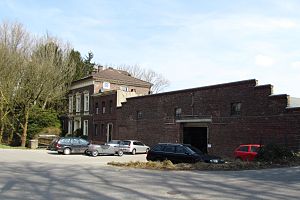Wickrath paper mill
| Wickrath paper mill
|
||
|---|---|---|
|
The current buildings of the Wickrath paper mill |
||
| Location and history | ||
|
|
||
| Coordinates | 51 ° 7 '44 " N , 6 ° 25' 29" E | |
| Location |
|
|
| Waters | Niers | |
| Built | 1708 | |
| Shut down | 1867 | |
| technology | ||
| use | Paper mill and oil mill | |
| Grinder | 1 grind 1 oil press | |
| drive | water wheel | |
| water wheel | overshot | |
The Wickrath paper mill was a water mill with an overshot water wheel on the upper reaches of the Niers in the Mönchengladbach district of Wickrath in the Düsseldorf administrative region .
geography
The Wickrath paper mill was located on the Niers flood ditch, at Neukircher Weg 10, in the Wickrath district of Mönchengladbach. Above was the Wickrath Castle Mill , below the Wetscheweller Mill . The area on which the mill building stands is at a height of approx. 62 m above sea level .
Waters
The Niers (GEWKZ 286) in its old river bed supplied numerous mills with water for centuries until the river was straightened . The Niers rises in Kuckum , a district of the city of Erkelenz . The Niers has a total length of 117.668 km and a total catchment area of 1,380.630 km 2 up to its confluence with the Meuse near Gennep (Netherlands) . The source is 73 m above sea level. NN , the mouth at 9 m above sea level. NN . The Niersverband is responsible for the care and maintenance of the water .
history
In 1708 the Lords of Wickrath built a paper mill southeast of the castle . For this purpose, the flood ditch that drained the Wickrather Bruch was connected to the Niers via a lock . The overshot mill was equipped with a pan mill and two vats . One of the first tenants was the Dutchman Wilhelm Greeven, who also built the Odenkirchen paper mill . The mill burned down in 1747, but was operational again a year later. In 1842 the mill was converted into an oil mill . In 1867 this time was over, because the mill was converted into a winding and weaving mill and, due to the changing water level, switched to a steam engine . The textile industry continued to work until after the Second World War .
gallery
The locations Wickrath and Wetschewell on the Tranchot map 1803-1820
literature
- Hans Vogt: Lower Rhine water mill guide 2nd edition. Verein Niederrhein, Krefeld 1998, ISBN 3-00-002906-0 , pages 481-483.
- Robert Lünendonk: The Niers and their mills 1st edition November 2012, ISBN 978-3-8375-0741-6 , pages 39-40, 87-89.
Web links
Individual evidence
- ^ German basic map 1: 5000
- ↑ http://www.lanuv.nrw.de/fileadmin/lanuv/wasser/pdf/Gewaesserverzeichnis%20GSK3C.xls
- ↑ Archived copy ( memento of the original from October 17, 2013 in the Internet Archive ) Info: The archive link was inserted automatically and has not yet been checked. Please check the original and archive link according to the instructions and then remove this notice.
- ↑ http://www.Niersverband.de/





